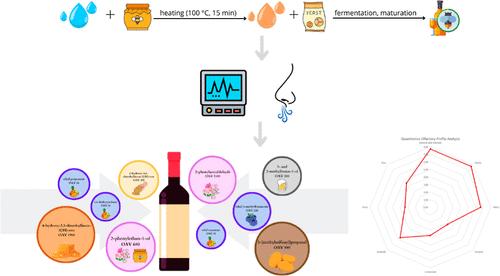当前位置:
X-MOL 学术
›
J. Agric. Food Chem.
›
论文详情
Our official English website, www.x-mol.net, welcomes your feedback! (Note: you will need to create a separate account there.)
Key Odorants Forming Aroma of Polish Mead: Influence of the Raw Material and Manufacturing Processes
Journal of Agricultural and Food Chemistry ( IF 6.1 ) Pub Date : 2024-04-26 , DOI: 10.1021/acs.jafc.4c01276 Daria Cicha-Wojciechowicz 1 , Stephanie Frank 2 , Martin Steinhaus 2 , Małgorzata Anna Majcher 1
Journal of Agricultural and Food Chemistry ( IF 6.1 ) Pub Date : 2024-04-26 , DOI: 10.1021/acs.jafc.4c01276 Daria Cicha-Wojciechowicz 1 , Stephanie Frank 2 , Martin Steinhaus 2 , Małgorzata Anna Majcher 1
Affiliation

|
Mead was analyzed by using the concept of molecular sensory science for the identification of key odorants. A total of 29 odor-active compounds were identified in mead by using gas chromatography olfactometry (GCO). Flavor dilution (FD) factors of identified compounds ranged from 1 to 16,384, compounds with FD factors ≥32 were quantitated by using stable isotopically substituted odorants as internal standards or external standard method, and odor activity values (OAVs) were calculated. Fifteen compounds showed OAVs ≥1: aldehydes (2-phenylacetaldehyde, 3-(methylsulfanyl)propanal), 4-hydroxy-3-methoxybenzaldehyde), esters (ethyl 3-methylbutanoate, ethyl propanoate, ethyl octanoate), alcohols (2-phenylethan-1-ol, 3- and 2-methylbutan-1-ol, 3-(methylsulyfanyl)propan-1-ol), furanons (4-hydroxy-2,5-dimethylfuran-3(2H)-one, 3-hydroxy-4,5-dimethylfuran-2(5H)-one), acids (3- and 2-methylbutanoic acid, acetic acid), 1,1-diethoxyethane, and 4-methylphenol. 2-Phenylacetaldehyde (OAV, 3100) was suggested as the compound with the biggest influence on the aroma of mead, followed by 4-hydroxy-2,5-dimethylfuran-3(2H)-one (OAV, 1900), 3-(methylsulfanyl)propanal (OAV, 890), and 2-phenylethan-1-ol (OAV, 680). Quantitative olfactory profile analysis revealed strong honey, malty, and alcoholic impressions. Omission experiments revealed that 3-(methylsulfanyl)propanal, 2-phenylethan-1-ol, 4-hydroxy-2,5-dimethylfuran-3(2H)-one, ethyl propanoate, ethyl 3-methylbutanoate, 2-phenylacetaldehyde, 3- and 2-methylbutanoic acid, 3-hydroxy-4,5-dimethylfuran-2(5H)-one, and 4-hydroxy-3-methoxybenzaldehyde were the key odorants in the mead. Determining concentrations of key odorants in important production steps showed that the fermentation and maturation stages had the strongest effect on the formation of mead aroma.
中文翻译:

形成波兰蜂蜜酒香气的主要气味物质:原材料和制造工艺的影响
利用分子感官科学的概念对米德进行分析,以鉴定关键气味物质。使用气相色谱嗅觉测定法 (GCO) 鉴定出蜂蜜酒中总共 29 种气味活性化合物。鉴定化合物的风味稀释(FD)因子范围为1至16,384,FD因子≥32的化合物采用稳定同位素取代的气味剂作为内标或外标法定量,并计算气味活性值(OAV)。 15 种化合物的 OAV ≥1:醛类(2-苯乙醛、3-(甲硫基)丙醛)、4-羟基-3-甲氧基苯甲醛)、酯类(3-甲基丁酸乙酯、丙酸乙酯、辛酸乙酯)、醇类(2-苯乙醛) 1-醇、3-和2-甲基丁-1-醇、3-(甲基磺基)丙-1-醇)、呋喃酮(4-羟基-2,5-二甲基呋喃-3(2 H )-酮、3-羟基-4,5-二甲基呋喃-2(5H ) -酮)、酸(3-和2-甲基丁酸、乙酸)、1,1-二乙氧基乙烷和4-甲基苯酚。 2-苯乙醛 (OAV, 3100) 被认为是对蜂蜜酒香气影响最大的化合物,其次是 4-羟基-2,5-二甲基呋喃-3(2 H )-酮 (OAV, 1900)、3- (甲硫基)丙醛 (OAV, 890) 和 2-苯基乙烷-1-醇 (OAV, 680)。定量嗅觉分析显示出强烈的蜂蜜、麦芽和酒精的味道。遗漏实验表明,3-(甲基硫基)丙醛、2-苯基乙醇-1-醇、4-羟基-2,5-二甲基呋喃-3(2H ) -酮、丙酸乙酯、3-甲基丁酸乙酯、2-苯乙醛、3 -和2-甲基丁酸、3-羟基-4,5-二甲基呋喃-2(5H ) -酮和4-羟基-3-甲氧基苯甲醛是蜂蜜酒中的主要气味剂。测定重要生产步骤中关键气味物质的浓度表明,发酵和成熟阶段对蜂蜜酒香气的形成影响最强。
更新日期:2024-04-26
中文翻译:

形成波兰蜂蜜酒香气的主要气味物质:原材料和制造工艺的影响
利用分子感官科学的概念对米德进行分析,以鉴定关键气味物质。使用气相色谱嗅觉测定法 (GCO) 鉴定出蜂蜜酒中总共 29 种气味活性化合物。鉴定化合物的风味稀释(FD)因子范围为1至16,384,FD因子≥32的化合物采用稳定同位素取代的气味剂作为内标或外标法定量,并计算气味活性值(OAV)。 15 种化合物的 OAV ≥1:醛类(2-苯乙醛、3-(甲硫基)丙醛)、4-羟基-3-甲氧基苯甲醛)、酯类(3-甲基丁酸乙酯、丙酸乙酯、辛酸乙酯)、醇类(2-苯乙醛) 1-醇、3-和2-甲基丁-1-醇、3-(甲基磺基)丙-1-醇)、呋喃酮(4-羟基-2,5-二甲基呋喃-3(2 H )-酮、3-羟基-4,5-二甲基呋喃-2(5H ) -酮)、酸(3-和2-甲基丁酸、乙酸)、1,1-二乙氧基乙烷和4-甲基苯酚。 2-苯乙醛 (OAV, 3100) 被认为是对蜂蜜酒香气影响最大的化合物,其次是 4-羟基-2,5-二甲基呋喃-3(2 H )-酮 (OAV, 1900)、3- (甲硫基)丙醛 (OAV, 890) 和 2-苯基乙烷-1-醇 (OAV, 680)。定量嗅觉分析显示出强烈的蜂蜜、麦芽和酒精的味道。遗漏实验表明,3-(甲基硫基)丙醛、2-苯基乙醇-1-醇、4-羟基-2,5-二甲基呋喃-3(2H ) -酮、丙酸乙酯、3-甲基丁酸乙酯、2-苯乙醛、3 -和2-甲基丁酸、3-羟基-4,5-二甲基呋喃-2(5H ) -酮和4-羟基-3-甲氧基苯甲醛是蜂蜜酒中的主要气味剂。测定重要生产步骤中关键气味物质的浓度表明,发酵和成熟阶段对蜂蜜酒香气的形成影响最强。





























 京公网安备 11010802027423号
京公网安备 11010802027423号